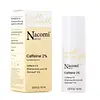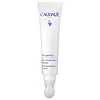What's inside
What's inside
 Key Ingredients
Key Ingredients

 Benefits
Benefits

 Concerns
Concerns

 Ingredients Side-by-side
Ingredients Side-by-side

Water
Skin ConditioningCoco-Caprylate/Caprate
EmollientButylene Glycol
HumectantGlycerin
HumectantButyrospermum Parkii Butter
Skin ConditioningPassiflora Incarnata Seed Oil
Skin ProtectingTrehalose
HumectantCetearyl Alcohol
EmollientGlyceryl Stearate
EmollientC12-15 Alkyl Benzoate
AntimicrobialCaffeine
Skin Conditioning3-O-Ethyl Ascorbic Acid
Skin ConditioningCetyl Alcohol
EmollientRosa Canina Seed Oil
EmollientSclerocarya Birrea Seed Oil
HumectantHydrolyzed Yeast Extract
Skin ConditioningMaltodextrin
AbsorbentStearic Acid
CleansingPotato Starch Modified
Tocopheryl Acetate
AntioxidantCentella Asiatica Leaf Extract
Skin ConditioningCalendula Officinalis Flower Extract
MaskingRuscus Aculeatus Root Extract
AstringentHydrolyzed Yeast Protein
Skin ConditioningPalmitoyl Hexapeptide-12
Skin ConditioningEscin
TonicCeramide Ng
Skin ConditioningTribehenin
EmollientLecithin
EmollientPanthenol
Skin ConditioningAmmonium Glycyrrhizate
MaskingLactic Acid
BufferingDehydroacetic Acid
PreservativePolyglucuronic Acid
Skin ConditioningCitric Acid
BufferingCetyl Hydroxyethylcellulose
Emulsion StabilisingSodium Citrate
BufferingSodium Lauroyl Glutamate
Xanthan Gum
EmulsifyingHydroxyethylcellulose
Emulsion StabilisingPhenoxyethanol
PreservativePotassium Sorbate
PreservativeSodium Benzoate
MaskingBenzyl Alcohol
PerfumingWater, Coco-Caprylate/Caprate, Butylene Glycol, Glycerin, Butyrospermum Parkii Butter, Passiflora Incarnata Seed Oil, Trehalose, Cetearyl Alcohol, Glyceryl Stearate, C12-15 Alkyl Benzoate, Caffeine, 3-O-Ethyl Ascorbic Acid, Cetyl Alcohol, Rosa Canina Seed Oil, Sclerocarya Birrea Seed Oil, Hydrolyzed Yeast Extract, Maltodextrin, Stearic Acid, Potato Starch Modified, Tocopheryl Acetate, Centella Asiatica Leaf Extract, Calendula Officinalis Flower Extract, Ruscus Aculeatus Root Extract, Hydrolyzed Yeast Protein, Palmitoyl Hexapeptide-12, Escin, Ceramide Ng, Tribehenin, Lecithin, Panthenol, Ammonium Glycyrrhizate, Lactic Acid, Dehydroacetic Acid, Polyglucuronic Acid, Citric Acid, Cetyl Hydroxyethylcellulose, Sodium Citrate, Sodium Lauroyl Glutamate, Xanthan Gum, Hydroxyethylcellulose, Phenoxyethanol, Potassium Sorbate, Sodium Benzoate, Benzyl Alcohol
Water
Skin ConditioningButylene Glycol
HumectantCaprylic/Capric Triglyceride
MaskingCoco-Caprylate/Caprate
EmollientCaffeine
Skin ConditioningCetearyl Alcohol
EmollientCetearyl Glucoside
EmulsifyingNiacinamide
SmoothingTriheptanoin
Skin ConditioningHydrogenated Vegetable Oil
EmollientSqualane
EmollientPalmitoyl Grapevine Shoot Extract
AntioxidantOleic Acid
EmollientGlyceryl Caprylate
EmollientCetyl Alcohol
EmollientPotassium Cetyl Phosphate
EmulsifyingCarbomer
Emulsion StabilisingTerminalia Arjuna Extract
Skin ConditioningXanthan Gum
EmulsifyingHelianthus Annuus Seed Oil
EmollientSodium Dehydroacetate
PreservativeTocopherol
AntioxidantSodium Hydroxide
BufferingLecithin
EmollientSodium Phytate
Water, Butylene Glycol, Caprylic/Capric Triglyceride, Coco-Caprylate/Caprate, Caffeine, Cetearyl Alcohol, Cetearyl Glucoside, Niacinamide, Triheptanoin, Hydrogenated Vegetable Oil, Squalane, Palmitoyl Grapevine Shoot Extract, Oleic Acid, Glyceryl Caprylate, Cetyl Alcohol, Potassium Cetyl Phosphate, Carbomer, Terminalia Arjuna Extract, Xanthan Gum, Helianthus Annuus Seed Oil, Sodium Dehydroacetate, Tocopherol, Sodium Hydroxide, Lecithin, Sodium Phytate
 Reviews
Reviews

Ingredients Explained
These ingredients are found in both products.
Ingredients higher up in an ingredient list are typically present in a larger amount.
Butylene Glycol (or BG) is used within cosmetic products for a few different reasons:
Overall, Butylene Glycol is a safe and well-rounded ingredient that works well with other ingredients.
Though this ingredient works well with most skin types, some people with sensitive skin may experience a reaction such as allergic rashes, closed comedones, or itchiness.
Learn more about Butylene GlycolCaffeine is most associated with coffee, tea, and cacao. In skincare, it helps with calming inflammation and is rich in antioxidants.
While caffeine is used to treat cellulite and and dark circles, further studies are needed to prove this. It has been believed to help with these skin conditions due to its ability to dilate blood vessels and increase blood flow.
Some studies are looking into caffeine's ability to protect against UV rays.
Learn more about CaffeineCetearyl alcohol is a mixture of two fatty alcohols: cetyl alcohol and stearyl alcohol. It is mainly used as an emulsifier. Emulsifiers help prevent the separation of oils and products. Due to its composition, it can also be used to thicken a product or help create foam.
Cetearyl alcohol is an emollient. Emollients help soothe and hydrate the skin by trapping moisture.
Studies show Cetearyl alcohol is non-toxic and non-irritating. The FDA allows products labeled "alcohol-free" to have fatty alcohols.
This ingredient is usually derived from plant oils such as palm, vegetable, or coconut oils. There is debate on whether this ingredient will cause acne.
Due to the fatty acid base, this ingredient may not be Malassezia folliculitis safe.
Learn more about Cetearyl AlcoholCetyl Alcohol is a fatty alcohol. Fatty Alcohols are most often used as an emollient or to thicken a product.
Its main roles are:
Though it has "alcohol" in the name, it is not related to denatured alcohol or ethyl alcohol.
The FDA allows products labeled "alcohol-free" to have fatty alcohols.
Learn more about Cetyl AlcoholCoco-Caprylate/Caprate is created from fatty coconut alcohol, caprylic acid, and capric acid.
It is a lightweight emollient. Emollients create a thin barrier on the skin to trap moisture in. This helps keep your skin hydrated and soft.
Once applied, Coco-Caprylate/Caprate is absorbed quickly and leaves a silky feel.
Coco-Caprylate/Caprate may not be fungal acne safe.
Learn more about Coco-Caprylate/CaprateLecithin is a term for a group of substances found in the cell membranes of plants, animals, and humans. They are made up of mixture of phospholipids.
This ingredient has emollient and emulsifying properties.
As an emollient, lecithen helps soften the skin and creates a barrier to keep moisture in.
As an emulsifier, it also helps prevent water and oil ingredients from separating. Lecithin can also help ingredients be better absorbed by the skin.
This is because the phospholipids in lecithin produce liposomes. Liposomes help other ingredients get through the skin barrier.
Depending on the source of this ingredient, lecithin may not be fungal acne safe. This is because some sources of lecithin come from soybean oil, which may feed the malassezia yeast that feeds fungal acne.
We recommend reaching out to the brand you are purchasing from to inquire about the source of their lecithin.
Some other names for this ingredient include soy lecithin and deoiled soy lecithin.
Learn more about LecithinWater. It's the most common cosmetic ingredient of all. You'll usually see it at the top of ingredient lists, meaning that it makes up the largest part of the product.
So why is it so popular? Water most often acts as a solvent - this means that it helps dissolve other ingredients into the formulation.
You'll also recognize water as that liquid we all need to stay alive. If you see this, drink a glass of water. Stay hydrated!
Learn more about WaterXanthan gum is used as a stabilizer and thickener within cosmetic products. It helps give products a sticky, thick feeling - preventing them from being too runny.
On the technical side of things, xanthan gum is a polysaccharide - a combination consisting of multiple sugar molecules bonded together.
Xanthan gum is a pretty common and great ingredient. It is a natural, non-toxic, non-irritating ingredient that is also commonly used in food products.
Learn more about Xanthan Gum